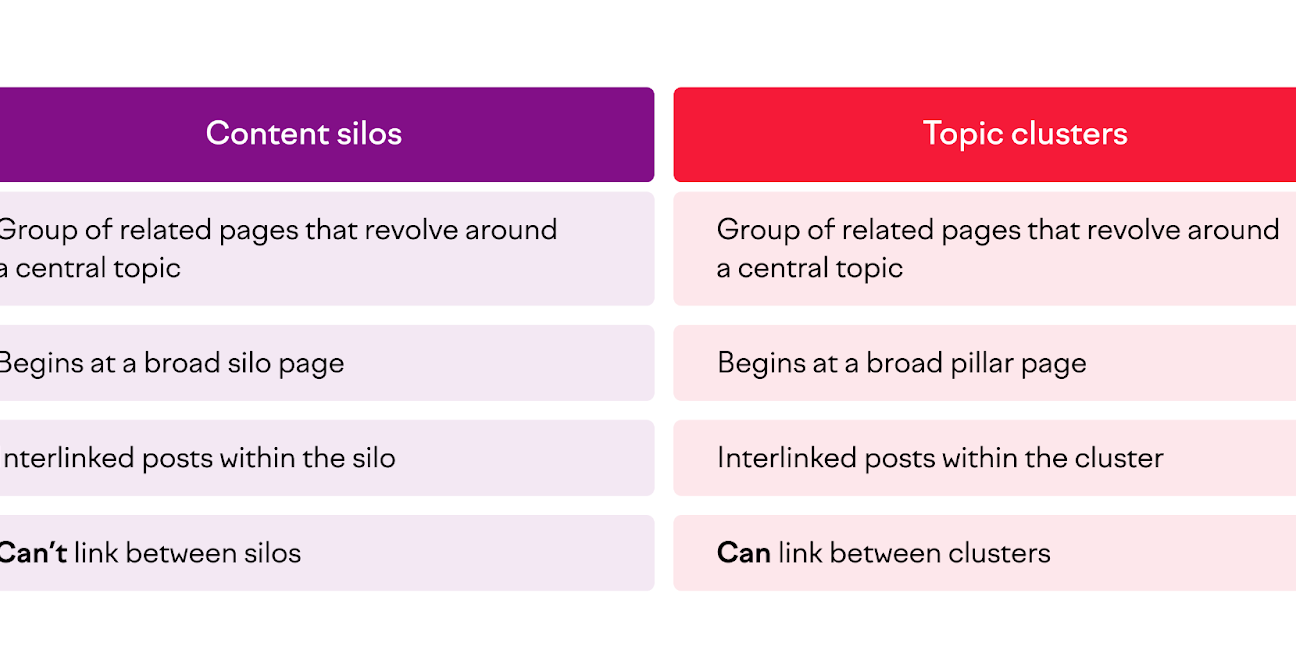Content Silos vs. Topic Clusters: Which SEO Structure Works Best in 2025?

As SEO evolves in 2025, so does the way we organize and present content. Gone are the days when dumping blog posts into a single “blog” folder was enough. Today, site structure and internal linking are critical for search rankings.
Two of the most talked-about frameworks are Content Silos and Topic Clusters.
But which one actually works better in 2025?
Let’s break down both models, compare their strengths, and give you actionable strategies to build a structure that ranks.
What is a Content Silo?
A content silo is an SEO site architecture where related pages are grouped under a specific section of the website. Each silo focuses on one broad topic and contains multiple related pages.
Example:
/seo/
/seo/on-page-seo/
/seo/technical-seo/
/seo/link-building/Pros:
- Clear topic segmentation
- Easy navigation and hierarchy
- Improved crawl efficiency
Cons:
- Can become rigid
- Limits interlinking outside silos
- Often overly dependent on directory structure
What is a Topic Cluster?
Topic clusters are a modern SEO framework where you create a pillar page (a comprehensive guide) around a broad topic, and then support it with several related cluster pages. These are internally linked in a web-like structure.
Example:
Pillar Page: /seo-guide-2025/
- Cluster: /seo/on-page-seo-tips/
- Cluster: /seo/semantic-seo-explained/
- Cluster: /seo/internal-linking-strategies/
Pros:
- Promotes topical authority
- Flexible and scalable
- Boosts internal linking for rankings
Cons:
- Requires planning and content depth
- Needs consistent updates
2025 SEO: Which Structure Performs Better?
1. Google’s Focus on Topical Authority
Search engines now prefer websites that cover a subject comprehensively. Topic clusters naturally support this by interlinking multiple detailed pages.
Winner: Topic Clusters
2. Internal Linking Power
Topic clusters are built around strategic internal links, which:
- Improve crawlability
- Spread link equity
- Reinforce semantic connections
Winner: Topic Clusters (again)
3. User Experience & Navigation
Content silos can be easier to understand structurally, but topic clusters offer smoother reading journeys by suggesting related reads.
Winner: Tie
4. Content Expansion & Flexibility
Topic clusters allow you to grow content without reorganizing your entire site.
Winner: Topic Clusters.
How to Transition from Silos to Clusters
If your site is structured in rigid silos, here’s how you can upgrade:
Step 1: Identify Pillar Opportunities
Find your most authoritative or broad-topic content pieces and turn them into pillar pages.
Step 2: Map Supporting Content
List out existing (and future) articles that support your pillar and answer sub-questions.
Step 3: Interlink Strategically
Use descriptive anchor text to link cluster articles to the pillar and vice versa. Don’t just use “click here”.
Step 4: Update Your Navigation
Ensure users can reach your cluster content easily – through breadcrumbs, sidebars, or hub pages.
Tools to Help Build Topic Clusters
| Tool | Use Case |
|---|---|
| Frase.io | Cluster content planning |
| Surfer SEO | Content optimization and NLP terms |
| Ahrefs | Topic research + internal link audits |
| MindMeister | Visual topic cluster mapping |
| Link Whisper | Internal linking suggestions (WP) |
Final Verdict: Topic Clusters Win in 2025
While content silos were foundational in early SEO, topic clusters are now the dominant strategy. They align with how Google understands content through NLP and how users navigate.
By shifting to topic clusters, you:
- Build topical authority
- Improve internal linking
- Future-proof your SEO strategy
If you’re ready to grow your rankings in 2025, it’s time to think in clusters, not folders.
Want to see topic clusters in action? Check out how ClickHype.co.uk organizes content with interlinked SEO hubs that drive authority and rankings.
Next Step: Read Internal Linking Strategies That Actually Boost Rankings to learn how to connect your content for better SEO results.










